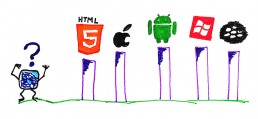Choosing to make an app and making it isn’t very hard. The trick is creating one that fits all your needs, while still adhering to the budget you have to work with. The good news is that you don’t have to break the bank to get what you’re looking for. In fact, you shouldn’t. By paying close attention to the factors that drive up (or save on) the cost of development, you can pick and choose the things that matter most in the moment.
Focus First on Your MVP

Let’s make sure we’ve looked at the basics first, and start by establishing the scope of the project. The minimum viable product (MVP) should focus on the key desired business outcomes that you’re hoping to achieve for your business. Get it to the point that it offers enough value for initial consumer interest, and enough benefit and promise to keep them engaged for the long run.
It’s true that relevant add-ons can set your app apart from the thousands of other apps on the market, but they’re seldom necessary from day one. Many of the bells and whistles you would enjoy having from the start are the very culprits behind skyrocketing project costs and inflated timelines. The future scalability of your app is incredibly important, so that down the road you can impress users with an updated experience and new features, without complication.
Take your time, build in phases and eventually your app can offer attractive additions, such as:
- Login conveniences (e.g. social, email, touch ID)
- Creating personal profiles
- The ability to make in-app purchases or leave reviews and ratings
- Complete control over customization (e.g. buttons, transitions, etc.)
- Music, photo capture, search bars, etc.
Cross-Platform Vs. Native

Uh-oh, cross-platform (or hybrid) vs. native app development. We’ve seen this choice before.
There are some types of apps that do well with cross-platform app development (those that don’t heavily lean on a device’s GPS or camera, for example), thus requiring only one codebase for all platforms. Others will have different needs, perhaps requiring that you launch natively on one platform and then another. Additionally, some apps don’t require a lot of custom UI/UX experience.
When apps qualify to be built with cross-platform programming languages (such as Flutter, React Native, or Cordova), the number of developers needed can be reduced. As a result, you’ll see significant savings on the cost of your app.
Security & Compliance

There’s no understating how important security is for both users and companies in 2018. With an embarrassing amount of data breaches and leaks in recent years, users need to know that the apps they’re using are secure – as is the crucial information that they’re trusting you with.
Features like payment processing, or requiring the user to enter personal identification information (PII) will require your custom app developer to create not only the features themselves, but additional protections for the application overall. This translates directly into the cost of building features like multi-factor authorization (MFA), as well as ensuring that financial transactions are completed without incident, as well as installing the processes to store sensitive data securely.
Team Size

While few apps require teams of 100+ engineers that companies like Facebook or Google might employ for a single project, there are still many moving parts throughout the development process. That means labor costs. All of the factors we’ve mentioned so far can directly translate into a specific, dedicated role for your project.
Other factors that can influence your team size are:
- Requiring innovative technologies like:
- AI (artificial intelligence), ML (machine learning), or VR/AR (virtual/augmented reality)
- Those in the blockchain industry may require additional developers or subject matter experts.
- How many established processes exist within the team for software delivery.
- If (and how) your app will integrate with other systems.
Team Location

The market you are in will absolutely influence costs. As an example, MOBILE-DI is Denver-based, which allows us to offer rates not nearly so expensive as developers in a location like San Francisco. Additionally, we spent years developing an efficient, agile operational framework with our dedicated offshore team. Because of onshore leadership that assumes full responsibility for project management and deliverables – available to answer questions, address issues and changes at any time – and a fully-integrated offshore team driving down costs, clients enjoy the best of both worlds.
It’s a hybrid approach that we’re proud of, and the rewards are numerous: Flexibility, responsiveness, affordability – and results.
Creative Pricing

Let’s get creative for a second. There are some think-outside-the-box ways to go where price is concerned. Maybe you’re looking for more than just fulfilment. Maybe you’d like to work with somebody who really believes in your app and would like some skin in the game. Well, why not consider trading aspects of the IP in exchange for a discounted rate? How about a convertible note? There’s no end of ways in which you can work with an app developer on price, especially if you’re willing to get flexible.
Non-Development Costs

So guess what? There are still additional costs to consider. Costs that don’t have anything to do with the development of the app itself. Crazy, right?
Other costs that aren’t always factored in can include ongoing maintenance, yearly fees and good, old-fashioned marketing. It’s important to market for early adoption of your app if you want to gain explosive momentum at launch. While how many users you would like to have and how many users you can afford to target are two different numbers, you still need to arrive at one. Then, when you take your CPI (cost per install) into account, you can determine a daily marketing spend that will forecast your budget.
Ways to market your app include:
- Paid Advertising
- Blogging
- App Store Optimization
- Influence Marketing
Get Your MVP Up and Running

How much you ultimately choose to spend on your app is between you and your budget. We always advocate focusing on your MVP to get your foot in the door, prove the product, and test the market before scaling. Doing so empowers you with a working tool for your users to start with, while you iterate upon the product to fit their needs (and your objectives) without spending thousands-upon-thousands of dollars running in a direction that doesn’t make sense for your business.
At MOBILE-DI, our team can help you determine what your MVP should look like based on your goals. With a variety of options to get started – and an enthusiastic, experienced team at your disposal – your company can make its big debut into the app world swiftly and efficiently.

